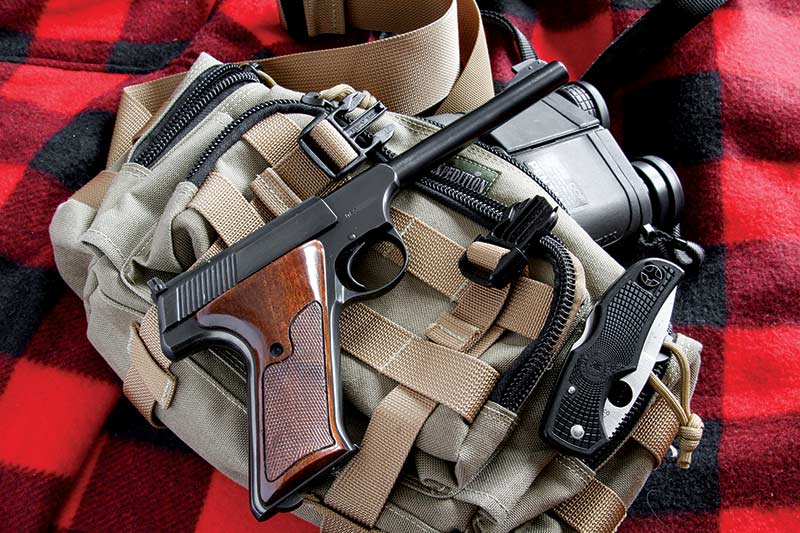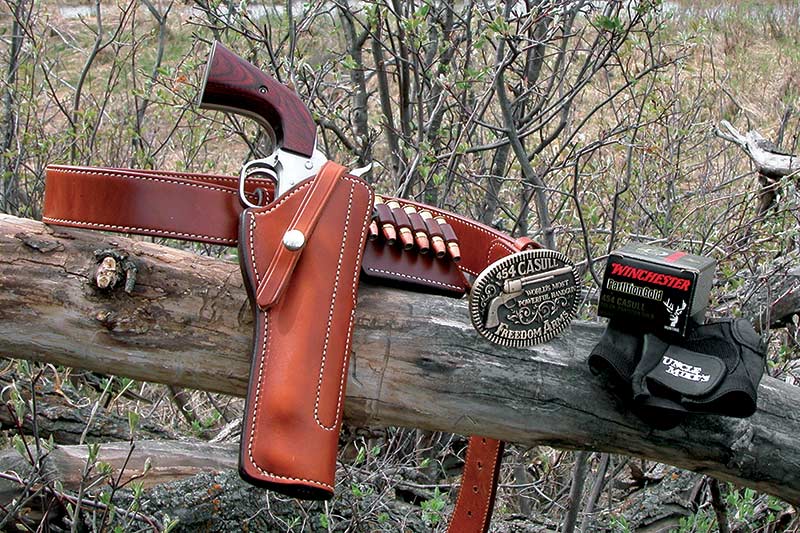Working Guns
My wife and I celebrated our 50th anniversary in 2023. Fifty years. It makes a man think about things that have changed and things that haven’t.
There was a time not so long ago when people who spent much time outdoors — trapping, prospecting, fishing, camping, surveying, farming, ranching, logging — and considered a firearm as part of their basic gear. It wasn’t always carried on the person; more likely, it was in a backpack, duffle bag, or even a fishing tackle box. Most often, these working guns were a .22 rimfire. Most often, it was a .22 rimfire. Casual firearm shooters often preferred a rifle, finding it easier to shoot accurately. Many .22 rifles in the 20th century (at least in the first half to two-thirds of the century) were takedown models for easier storage and transport.
Those who were willing to learn to shoot a handgun liked the convenience and compact size of a .22 handgun. Factories gave them names suggesting the market they were intended to serve, such as the Colt Woodsman, S&W K22 Outdoorsman, Browning Nomad, High Standard Sport King and the compact S&W Kit guns. “Kit” in those times was not meant to describe a kit of parts to be assembled but referred to the outdoorsman’s gear. A trapper in his kit bag might have items such as matches, compass, knife, cord, fish hooks and line, first aid items, salt and pepper, beef jerky and rock candy and a little S&W .22 revolver.
The Original “Kit” Guns
I’ve had a rimfire rifle or pistol more or less at hand for the past 60 years. An acquaintance once said, “I don’t have a firearm when I’m outdoors; what do you use it for?” I explained having a gun handy is part of everyday life, like a pocketknife. He said, “Well, I don’t carry a pocketknife either.” Yes, believe it or not, there are such people. How to explain these are simply things we do? Either you get it, or you don’t. It might not happen often, but sometimes there’s a situation where something needs to be shot or cut, and you can’t always predict when it might occur. Anyway, I haven’t seen this person in years. He probably couldn’t start a fire in the rain or tie a bowline, either.
As a bona fide old-timer, my .22 pistols are out of production — sometimes collector items. Examples include Beretta 71, Colt Woodsman, S&W Kit Guns (both .22 and .22 Magnum), Ruger .22 Auto and Browning Challenger. While there haven’t been dramatic breakthroughs, current models have one potential advantage: resistance to rust. Polymers, stainless steel and rust-resistant coatings offer worthwhile benefits. If I had to pick just one? Probably my Browning Challenger made in 1964. Current production? Semiauto: likely the Browning Buckmark Camper stainless. Revolver: Ruger SP-101.
larger “Kit”
The second working group of outdoor handguns includes those for defense against predators, which in North America mostly means bears. Old-timers recall Dirty Harry saying, “This is a .44 Magnum, the most powerful handgun in the world …” in 1971. The decades since have seen the introduction of both factory and wildcat cartridges far more powerful such as the .454 Casull, .460 and .500 S&W, and .480 Ruger.
I don’t have a lot of experience with defense against bears. On three occasions, I’ve deployed my handgun against black bears, never against one of the big bears. The handgun was a Ruger .44 Magnum Super Blackhawk, which I mainly used for metallic silhouette competition. I never had to fire at a bear, though in one case, I had about 2 lbs. of pressure on a 3-lb. trigger when the bear turned and ambled off.
Currently, I like the Freedom Arms .454 Casull. My example has a 6″ barrel and factory-tuned trigger; it is beautifully made and incredibly accurate. For carry in bear country when working, hiking or fishing, there are compact versions of powerful revolvers including the .500 S&W. My only concern with these big cartridges is recoil.
The recoil factor seems to be the main reason why the 10mm Auto has become popular as bear repellent. The rationale seems to be no handgun can surely stop a big bear except with a bullet to the brain, which is more easily accomplished with a lighter recoiling semiauto holding lots of cartridges. If it works for you, I won’t argue. I see lots of shooters on the range who can’t hit a motionless 6″ target and doubt it is any easier when the target is moving, and the shooter is in fear for his life. I used to spend more time in grizzly country than I do now, but if I do so again, I want a rifle — a BIG rifle.







